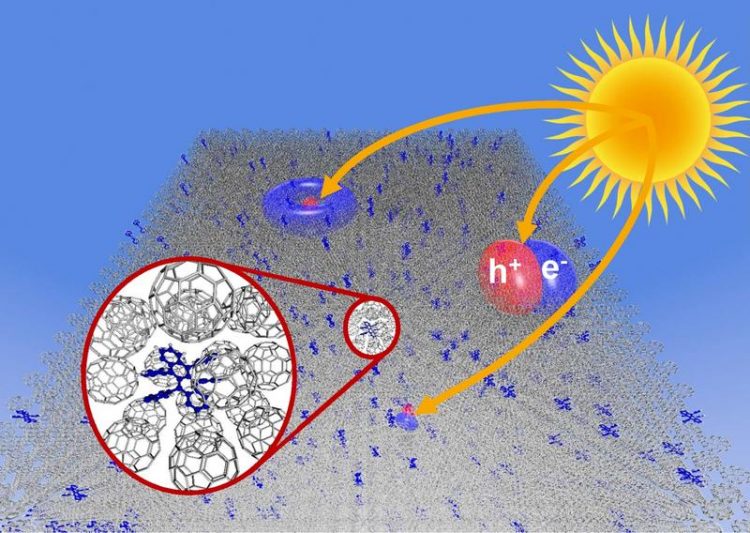On the trail of organic solar cells’ efficiency

Illustration of the generation of charge pairs (excitons), the precursors of free charge carriers in the active layer of an organic solar cell. M. Panhans
Scientists at TU Dresden and Hasselt University in Belgium investigated the physical causes that limit the efficiency of novel solar cells based on organic molecular materials. Currently, the voltage of such cells is still too low – one reason for their still relatively low efficiencies.
In their study, by investigating the vibrations of the molecules in the thin films, the scientists were able to show that very fundamental quantum effects, so-called zero point vibrations, can make a significant contribution to voltage losses. The study has now been published in the journal Nature Communications.
Solar cells are a crystallization point of high hopes for the necessary transformation of the global energy production. Organic photovoltaics (OPV), which is based on organic, i.e. carbon-based materials, could be ideally suited to become an important pillar in the energy mix of the “renewables” because they have a better ecological balance sheet compared to conventional silicon-based modules and only a small amount of material is required to produce the thin films.
However, a further increase in efficiency is necessary. It is based on various characteristic values such as the open-circuit voltage, whose too low values are currently a main reason for still quite moderate efficiencies of OPV.
The study investigated physical reasons for this – including the vibrations of the molecules in the thin films. It was shown that the so-called zero point vibrations – an effect of quantum physics that characterizes the motion at absolute temperature zero – can have a significant influence on voltage losses.
A direct relationship between molecular properties and macroscopic device properties was demonstrated. The results provide important information for the further development and improvement of novel organic materials.
The low energy edge of optical absorption spectra is crucial for the performance of solar cells, but in the case of organic solar cells with many influencing factors it is not yet well understood. In the present study, the microscopic origin of absorption bands in molecular blend systems and their role in organic solar cells was investigated.
The focus was on the temperature dependence of the absorption characteristics, which was investigated theoretically under consideration of molecular vibrations. The simulations matched very well with the experimentally measured absorption spectra which leads to a number of important findings.
The authors discovered that the zero-point vibrations, mediated by electron-phonon interaction, cause a considerable absorption bandwidth. This leads to reemission of a part of the energy which is unused and hence reduces the open-circuit voltage. These voltage losses can now be predicted from electronic and vibronic molecular parameters.
What is unusual is that this effect is strong even at room temperature and can significantly reduce the efficiency of the organic solar cell. Which strategies to reduce these vibration-induced voltage losses could be applied is being discussed by the authors for a larger number of systems and different heterojunction geometries.
Institutions involved:
• Technische Universität Dresden: Center for Advancing Electronics Dresden (cfaed), Dresden Integrated Center for Applied Physics and Photonic Materials (IAPP), Institute for Applied Physics
• Hasselt University, Belgium: Institute for Materials Research (IMO-IMOMEC)
About the Computational Nanoelectronics Group:
The research group at the Center for Advancing Electronics Dresden (cfaed) headed by Dr. Frank Ortmann investigates electronic properties and charge transport properties of novel semiconductor materials. Here, organic semiconductors are currently an important focus of the work, which is funded by the German Research Foundation under the Emmy Noether Program. The group has been based at the cfaed since 2017.
Info: https://cfaed.tu-dresden.de/ortmann-home
Media inquiries:
Matthias Hahndorf
cfaed, Science Communications
Phone: +49 351 463-42847
E-mail: matthias.hahndorf@tu-dresden.de
cfaed
cfaed is a research cluster at TU Dresden (TUD). As an interdisciplinary research center for perspectives of electronics it is located at the TUD as the central scientific unit, but also integrates nine non-university research institutions in Saxony as well as TU Chemnitz as cooperating institutes. With its vision, the cluster aims to shape the future of electronics and initiate revolutionary new applications, such as electronics that do not require boot time, are capable of THz imaging, or support complex biosensor technology. These innovations make conceivable performance improvements and applications that would not be possible with the continuation of today's silicon chip-based technology. In order to achieve its goals, cfaed combines the thirst for knowledge of the natural sciences with the innovative power of engineering.
Wissenschaftliche Ansprechpartner:
Dr. Frank Ortmann
Technische Universität Dresden
Center for Advancing Electronics Dresden (cfaed)
Tel.: +49 351 463-43260
E-Mail: frank.ortmann@tu-dresden.de
Molecular vibrations reduce the maximum achievable photovoltage in organic solar cells
DOI: 10.1038/s41467-020-15215-x
Authors: Michel Panhans, Sebastian Hutsch, Johannes Benduhn, Karl Sebastian Schellhammer, Vasileios C. Nikolis, Tim Vangerven, Koen Vandewal, Frank Ortmann
Media Contact
All latest news from the category: Power and Electrical Engineering
This topic covers issues related to energy generation, conversion, transportation and consumption and how the industry is addressing the challenge of energy efficiency in general.
innovations-report provides in-depth and informative reports and articles on subjects ranging from wind energy, fuel cell technology, solar energy, geothermal energy, petroleum, gas, nuclear engineering, alternative energy and energy efficiency to fusion, hydrogen and superconductor technologies.
Newest articles

NASA: Mystery of life’s handedness deepens
The mystery of why life uses molecules with specific orientations has deepened with a NASA-funded discovery that RNA — a key molecule thought to have potentially held the instructions for…

What are the effects of historic lithium mining on water quality?
Study reveals low levels of common contaminants but high levels of other elements in waters associated with an abandoned lithium mine. Lithium ore and mining waste from a historic lithium…

Quantum-inspired design boosts efficiency of heat-to-electricity conversion
Rice engineers take unconventional route to improving thermophotovoltaic systems. Researchers at Rice University have found a new way to improve a key element of thermophotovoltaic (TPV) systems, which convert heat…



